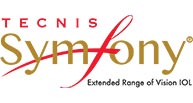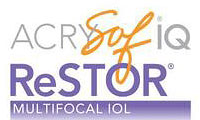Beyond Clarity: Exploring the Impact on Up-Close Tasks Post-Surgery
Cataract surgery is very good at helping people to see better at a distance; for example, you may be able to see the television or to drive without eyeglasses after this surgery. However, reading and doing other up-close work may be harder. Multifocal lens implants can be placed into your eyes to improve up-close images, giving you better vision overall. When you visit us in Manhattan & Brooklyn, our eye surgeon will have a detailed discussion with you about multifocal lens implants.
Types of premium lens implants
Tecnis Symfony
Symfony, the latest advancement in IOL (Intraocular Cataract Lenses) optical technology are the first and only FDA approved presbyopia-correcting Extended Range of Vision lenses.
Unlike traditional multifocal lenses, Symfony targets Presbyopia which is farsightedness caused by the loss of elasticity in the lens due to aging. Recovery from surgery is minimal where patients can return to their usual routine 24 hours after surgery. Symfony patients also reported a low incidence of glares & halos, a common side effect caused by traditional lens implants.

Unlike traditional multifocal lenses, Symfony targets Presbyopia which is farsightedness caused by the loss of elasticity in the lens due to aging. Recovery from surgery is minimal where patients can return to their usual routine 24 hours after surgery. Symfony patients also reported a low incidence of glares & halos, a common side effect caused by traditional lens implants.
Symfony Extended Range of Vision IOL is available in both a Non-Toric version and a Toric version for patients with astigmatism.

Crystalens® — Far, near and everything in-between
Crystalens, manufactured by Bausch & Lomb, gained FDA approval in late 2003. A newer version of the IOL, known as Crystalens HD, was approved by the FDA in June 2008.
Crystalens was designed to restore the ability of the eye to focus, or accommodate, which is gradually reduced in patients after the age of 40.
Crystalens implants can give individuals clear reading vision (within 1 to 2 feet), arm’s-length vision (2 to 3 feet), and distance vision without glasses, because the implant actually adjusts its position within the eye as the eye looks from far to near subjects, just like the autofocus mechanism on a camera. Most people with Crystalens implants have clear distance and intermediate vision without any need for glasses. This enables them to drive, watch TV, and use a computer, all without eyeglasses. About 90 percent of people can also read newsprint unaided after receiving Crystalens implants.
ReStor® — The space-age
AcrySof ReSTOR, manufactured by Alcon, uses apodized diffractive technology — a design that responds to how wide or small the eye’s pupil is — to provide near, intermediate, and distance vision. Clinical studies used to support the March 2005 FDA approval showed that 80 percent of people who received the lens didn’t use glasses for any activities after their cataract surgery.
The ReSTOR lens is a nonmoving lens implant. Alcon’s high-tech manufacturing process creates a gradual blending of focusing power throughout the entire lens surface.

With the ReSTOR lens, over 90 percent of people can clearly see distant objects, such as road signs, as well as near objects, such as reading material within one to two feet, especially in good light. As with all multifocal lenses, a period of adjustment is required for your brain to get used to the lens. The length of the adjustment period depends on several factors, including your age and your vision requirements.

TECNIS® Multifocal IOL Youthful vision after cataracts
The Tecnis Multifocal IOL from Abbott Medical Optics is a diffractive artificial lens with specific zones that provide near, intermediate, and distance vision. Company officials say the lens has a proprietary design to enhance vision at all distances without depending on the size of the pupil as it expands in low light or constricts in bright light. The Tecnis lens is shaped to correct for certain higher-order aberrations, which helps improve the ability to see contrasting objects, particularly at night. AMO reported a 95 percent patient satisfaction rate in clinical trials leading to FDA approval in early 2009.
Multifocal Lens Implants Patient Testimonials

What are the advantages of Multifocal Lens Implants?
Multifocal lens implants have certainly been a game-changer when it comes to cataract surgery. They may not be right for everyone, but for most of our New York Laser Vision patients, the advantages outweigh any disadvantages.
These are the pluses of these amazing lenses:
- Freedom — These lenses allow you to see clearly at all distances without needing glasses. For many people, this could be the first time in their lives that they haven’t had to have some sort of glasses, either for refractive errors (nearsightedness, farsightedness, astigmatism) or for presbyopia after age 40. While some patients still may require occasional use of reading glasses for very fine print, most don’t need them again. No more searching for your reading glasses or squinting.
- No upkeep or maintenance — These are permanent implanted lenses. There will no longer be any need to replace contact lenses or eyeglasses.
- Reduced lifetime costs — Patients no longer need multiple pairs of reading glasses strategically placed around the house.
What are the disadvantages of Multifocal Lens Implants?
- Difficulty seeing up close — For some people, multifocal lenses don’t quite deliver perfect up-close vision, and they can still sometimes require reading glasses.
- Somewhat lower quality distance vision — If you need absolutely crystal-clear distance vision, then you may not be able to tolerate the slight decrease in the level of quality you may find with multifocal lenses.
- Night vision, halos, glare — Some patients develop halos and glare surrounding lights after dark, along with reduced night vision quality. This usually fades over time, however, as only about one percent of multifocal lens implant patients reporting persistent night vision complaints.
- Cost — Multifocal lenses cost more than monovision, although most patients feel the freedom is worth the added cost.
Since the first day, I went to New York Laser Vision, I was treated like I was a movie star. Everyone was 100% and all the tests are given with complete care for the patient. I never felt one drop of pain and my vision is crystal clear. 100%. Thank you so much Dr. Julia Giyaur, I can see again!”
Rich
What are the risks of getting Multifocal Lens Implants?
The risks with multifocal IOLs are the same as with any implanted IOLs. The general risks of any IOL are below. Specific to multifocal lens implants are the potential for the person to see halos and glare surrounding lights at night. There also is a chance of having decreased night vision. These issues usually correct themselves with time in 99 percent of patients. Cataract surgery is among the most common and successful surgical procedures performed today.
Over three million Americans have cataract surgery yearly with an overall success rate over 98 percent. Complications are very rare, but they include:
- Posterior capsule opacity
- Intraocular lens dislocation
- Eye inflammation
- Light sensitivity
- Photopsia (flashes of light)
- Macular edema (swelling of the central retina)
- Ptosis (droopy eyelid)
- Ocular hypertension (elevated eye pressure)
As mentioned, these complications are very rare, but most are minor and can be successfully addressed medically or with additional surgery.
What should I expect at my Cataract Surgery consultation?
There are several FDA-approved implantable multifocal lenses available, including AcrySof IQ ReSTOR, Tecnis Multifocal, and Tecnis Symfony lenses. When you come in for your exam, we’ll discuss all the options to determine which is best for your needs.
What does a Multifocal Lens Implant preocesure involve?
Implanted lenses work a bit differently than bifocal eyeglasses. A multifocal lens is specifically designed to provide for distance, near and intermediate vision at the same time. In contrast, bifocals require you to look through different portions of the lens to see clearly at various distances, whether you’re reading a menu, looking at your computer screen, or identifying a neighbor across the street.
During the procedure, the surgeon creates a small, nearly invisible, incision in the eye, removes the cataract or crystalline lens and inserts the lens implant. The incision is so tiny that usually no stitches are required.
It’s important to talk to our team about your vision, your overall health, and the benefits you hope to gain from multifocal lens implants. When you come in for a consultation with us in our Manhattan or Brooklyn offices, we will discuss multifocal lens implants with you in detail.
How long does cataract surgery take?
Cataract surgery is amazing. The entire surgery, from making the initial incision to breaking up and removing the clouded cataract to placing the replacement intraocular lens, takes just 10-15 minutes!
Is Cataract Surgery painful?
Before the implant procedure begins, you will receive sedation and numbing agents, so you will not experience any pain.
What is the recovery process for Multifocal Lens Implants?
Recovery is no different when receiving any type of IOL. Immediately after surgery, an eye patch is worn. Someone will need to drive you home. We will also give you a protective shield to wear when sleeping for several days. Vision may be blurry at first, but rapidly improves within a few days. This is completely normal. There will be some itching and discomfort, but it is important not to rub or exert pressure on the treated eye. Heavy lifting is out, as it puts pressure on the eyes. Eye drops prevent inflammation and infection and control eye pressure.
Your normal activities can usually be resumed in a few days. Full healing should be complete in about one month. If both eyes have cataracts, we will schedule the second eye for surgery one or two months after the first.
How long will it take until I can drive after having my surgery?
Most of our New York Laser Vision patients can resume driving as soon as 24 hours after their surgery. This can vary by patient. Dr. Giyaur will see you the day after your procedure to make sure everything is going well, and she will discuss driving and other activities with you then.
If you are interested in learning more about our Multifocal Lens Implant options and procedures, call us to schedule a consultation. New York Laser Vision is proud to serve Manhattan, Brooklyn, and the surrounding areas.
Financing Options








